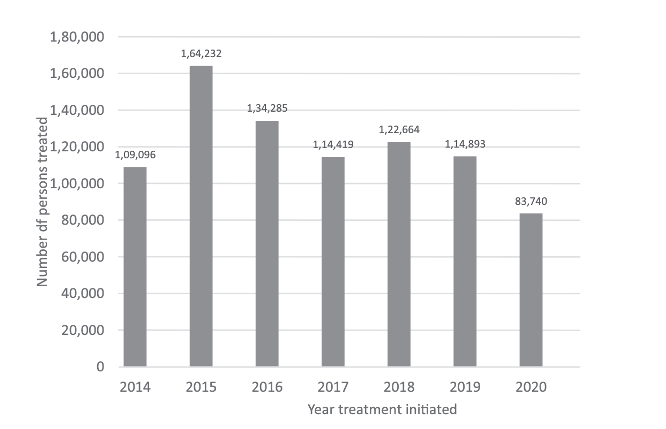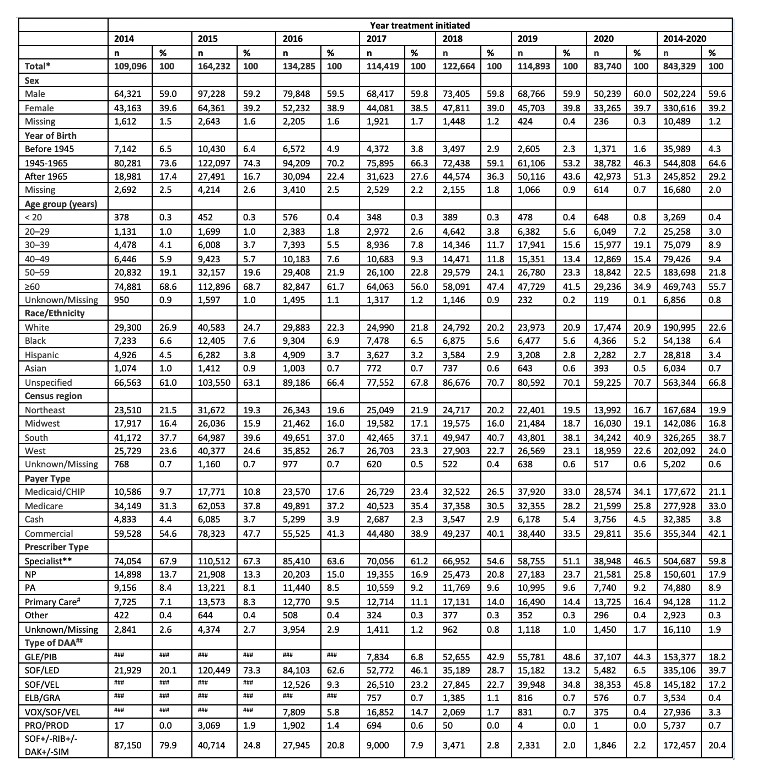| |
New HCV DAA Treatments Initiations 2020 Decreasing
|
| |
| |
Download the PDF here
Characteristics of Persons Treated for Hepatitis C Using National Pharmacy Claims Data, United States, 2014-2020
Clinical Infectious Diseases 16 February 2022
The proportion of all treated persons in the baby boomer cohort decreased from 73.6% in 2014 to 46.3% in 2020; whereas the proportion of all treated persons born after 1965 increased from 17.4% to 51.3% over this same period. [so we are missing older newly acute or chronic diagnosed people and there are a lot, Jules]
When accounting for approximately 110 000 persons treated by the Veteran's Health Administration [6], we estimate 1.2 million persons were treated, which equates to an average of 171 000 patients prescribed HCV DAAs annually.
This number is far below the goal set by the NASEM, that is, that 260 000 patients be treated annually to eliminate hepatitis C as a public health threat by 2030 [7].
In the United States during 2013-2018, an estimated 61% of people with hepatitis C were aware of their infection. Lack of awareness of HCV infection status is a significant barrier for linking patients to care, which is necessary for access to DAA treatment. To accomplish the national goal of eliminating hepatitis C, it is imperative that both awareness of HCV infection status and linkage to care for HCV-infected persons are improved.
Using national pharmacy claims, we found that 843 329 people were treated for hepatitis C during 2014-2020. The annual number of persons treated was highest in 2015, soon after DAAs became widely available; the number was substantially lower in 2020 during the coronavirus disease 2019 pandemic. Although IQVIA provides a comprehensive picture of HCV DAA prescribing patterns nationally, estimates for prescription coverage of HCV DAAs by channel type varied over the study period as follows: retail pharmacies (range, 91%-95%), mail order pharmacies (range, 66%-76%), and long-term care pharmacies (range, 73%-86%). When adjusting for nonparticipating pharmacies using prescribing patterns observed in the IQVIA data, we estimate that 1.08 million persons were treated during this period.
Figure 1. Number of persons treated for hepatitis C with direct-acting antiviral agents by year, United States, 2014-2020. Data from IMS Health & Quintiles longitudinal prescription claims database.

Number and proportion of persons treated for hepatitis C with direct-acting antiviral agents by demographic, payer and prescriber characteristics, United States, 2014-2020: Data from IMS Health & Quintiles (IQVIA) longitudinal prescription claims database

| |
| |
| |
|
|
|